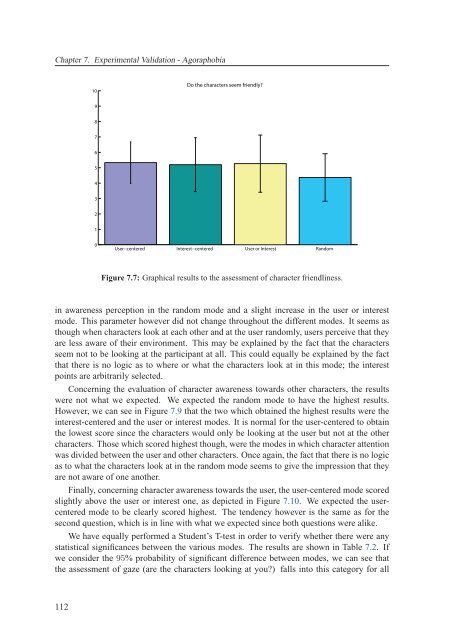Texte intégral / Full text (pdf, 20 MiB) - Infoscience - EPFL
Texte intégral / Full text (pdf, 20 MiB) - Infoscience - EPFL
Texte intégral / Full text (pdf, 20 MiB) - Infoscience - EPFL
You also want an ePaper? Increase the reach of your titles
YUMPU automatically turns print PDFs into web optimized ePapers that Google loves.
Chapter 7. Experimental Validation - Agoraphobia<br />
10<br />
9<br />
8<br />
7<br />
6<br />
5<br />
4<br />
3<br />
2<br />
1<br />
0<br />
Do the characters seem friendly?<br />
User−centered Interest−centered User or Interest Random<br />
Figure 7.7: Graphical results to the assessment of character friendliness.<br />
in awareness perception in the random mode and a slight increase in the user or interest<br />
mode. This parameter however did not change throughout the different modes. It seems as<br />
though when characters look at each other and at the user randomly, users perceive that they<br />
are less aware of their environment. This may be explained by the fact that the characters<br />
seem not to be looking at the participant at all. This could equally be explained by the fact<br />
that there is no logic as to where or what the characters look at in this mode; the interest<br />
points are arbitrarily selected.<br />
Concerning the evaluation of character awareness towards other characters, the results<br />
were not what we expected. We expected the random mode to have the highest results.<br />
However, we can see in Figure 7.9 that the two which obtained the highest results were the<br />
interest-centered and the user or interest modes. It is normal for the user-centered to obtain<br />
the lowest score since the characters would only be looking at the user but not at the other<br />
characters. Those which scored highest though, were the modes in which character attention<br />
was divided between the user and other characters. Once again, the fact that there is no logic<br />
as to what the characters look at in the random mode seems to give the impression that they<br />
are not aware of one another.<br />
Finally, concerning character awareness towards the user, the user-centered mode scored<br />
slightly above the user or interest one, as depicted in Figure 7.10. We expected the usercentered<br />
mode to be clearly scored highest. The tendency however is the same as for the<br />
second question, which is in line with what we expected since both questions were alike.<br />
We have equally performed a Student’s T-test in order to verify whether there were any<br />
statistical significances between the various modes. The results are shown in Table 7.2. If<br />
we consider the 95% probability of significant difference between modes, we can see that<br />
the assessment of gaze (are the characters looking at you?) falls into this category for all<br />
112

















